In our previous history-of-Fritz birthday report I told you about Armand Rousso, the man who showcased his 3D technology by staging a virtual reality match (17 years ago!) between Garry Kasparov and X3D Fritz in New York. It was an unprecedented media success. After that great success Armand, the ever enterprising businessman, went on to launch a new search engine that aimed in taking traffic away from Google.
I was with Armand in Paris and watched him searching for a name for the search engine. Morphy was the first idea of the chess aficionado. But then he went for a name that had two o's in it – just like the market giant he intended to take on.

Accoona was a service that was supposed to use artificial intelligence to better understand searches. I described how it worked in this article. First experiments with Accoona fascinated me: when I used it to search for "Garry Kasparov", one entry caught my eye: "3 lives lost, 2 broken" led to an article in the Detroit Free Press that has nothing to do with chess or Kasparov (in fact both words did not occur in the text). But it did contain the name of a victim in a traffic accident: "Gary Weinstein". The AI in the Accoona search engine apparently knew that Kasparov's original name was Gary Weinstein and has retrieved (here inappropriately) a story with this name.
In December 2004 Accoona was launched, in a swanky restaurant, Tavern on the Green on West Central Park, New York, with a glittering array of special guests. I was invited and attended.
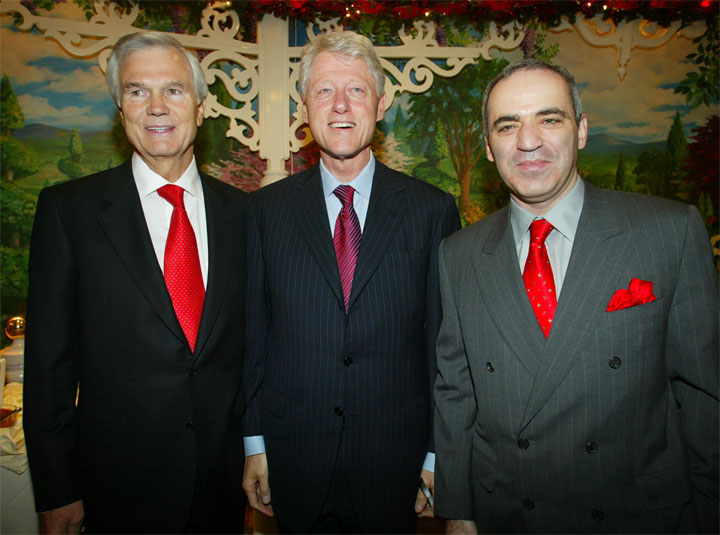
Among the special guests were Accoona’s Chairman of the Board, Eckhard Pfeiffer, former CEO of Compaq Computers, who was serving on the boards of General Motors and Ericsson; former US president Bill Clinton, and Garry Kasparov.
I have described the launch evening in this article. I was especially impressed by Clinton's keynote speech, which I transcribed in full in my report. The 42nd President of the United States immediately had the audience enthralled. He was eloquent and intelligent, knowledgeable on the subject, effortlessly finding a rapport with the computer people gathered in the hall.
I had the opportunity to chat with Clinton in the VIP suite. I told him he looked a little frail, and he explained that it was from a four-hour quadruple bypass operation he had undergone three months earlier. He went on to give me some very valuable cardiological advice, which I took to heart (pun intended) when I returned to Germany.
Accoona was moderately successful – it was named one of the "50 Coolest Websites of 2006" by Time magazine – and engaged in exclusive partnership with China Daily, a giant Chinese internet portal. But, as you probably guess, it failed to challenge the supremacy of Google. In 2008 it was acquired by Masterseek, the Danish business-to-business search engine, which now encompasses 175 million business profiles, 346 million websites, and 450 million contacts, making it the largest commercial database in the world.
AI Accoona ToolBar vs Rustam Kasimdzhinov
When I was in New York for the Accoona launch, I stayed in Armand's flat. There we came up with an ambitious plan: to join forces and develop a chess program that learns from experience. Every game it plays should be sent to a central server, where it is analysed by AI engines, which locate weaknesses and suggest possible improvements. These are automatically integrated into the chess program, which becomes progressively stronger as it plays tens and then hundreds of thousands of games.
Easier said than done. But Armand could not wait, and announced an "experimental AI project being developed jointly by Accoona and the leading German chess software company ChessBase." And, after the great success of his Kasparov vs X3d Fritz match, he started looking for another chess event to publicise Accoona. But who should play the program?
Rustam Kasimdzhanov! The Uzbek grandmaster had just won the Tripoli FIDE World Championship, and, in spite of the difficult to pronounce name, he would be the ideal opponent for Fritz. Armand invited Rustam to New York.
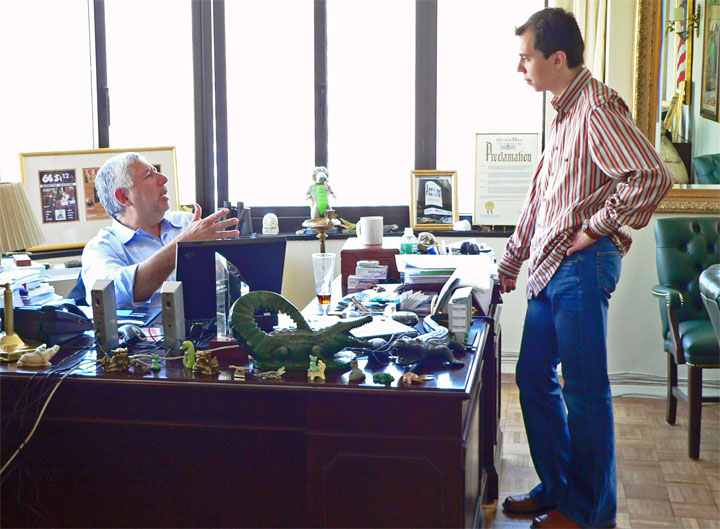
Armand and Rustam working out the details of the match in the Accoona office
There was one problem, though: how to name the computer opponent. Wary of the massive publicity Fritz was getting from the matches, Armand decided to somewhat cumbersomely call the experimental Fritz the "AI Accoona ToolBar", and in fact commissioned ChessBase to develop a utility with a chess link which took you to a special page where you could read news, solve chess puzzles (a new one every day), and play against a small Java applet that would load in your browser and was ready to play within seconds.
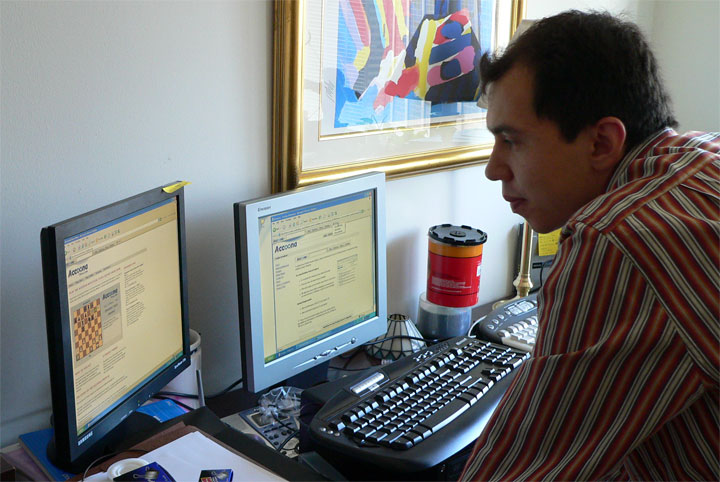
Rustam checking out the Accoona-ChessBase utility that played chess against amateurs

The public game took place in the ABC Times Square studios. With three hundred spectators and a dozen television cameras. Kasimdzhanov played against a prototype version of Fritz 9, based on strategic and tactical understanding rather than purely on a brute force search. The program ran on a simple, off-the-shelf notebook computer.

Kasimdzhanov played a daring attacking game that left the spectators enthralled
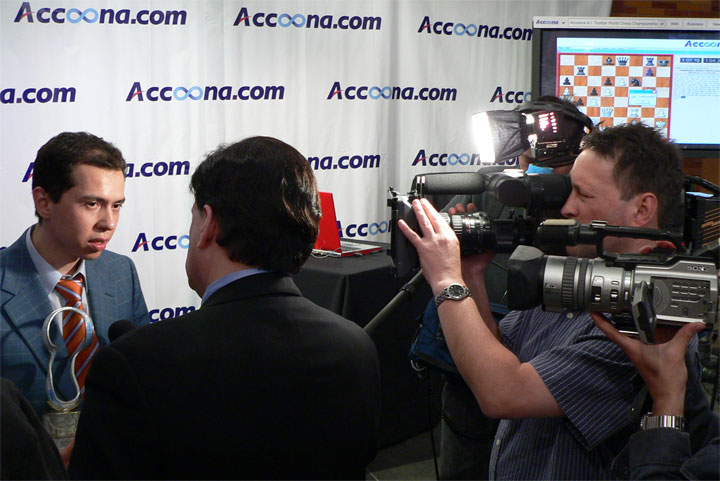
After the game Rustam told the audience that he thought he was totally winning, but had made the mistake of using up too much time. "It is impossible to work out all the complications when you are essentially playing on the ten-second increment – and you are facing the terrible precision of this machine."
There is one little personal story I need to tell. About a decade earlier I had been a board member of the Professional Chess Association (PCA), a rival organisation to FIDE, and got into a very hostile dispute with Gata Kamsky (and especially his father). I hadn't seen them for a number of years. During the match, Gata suddenly walked in. Would we come to blows?
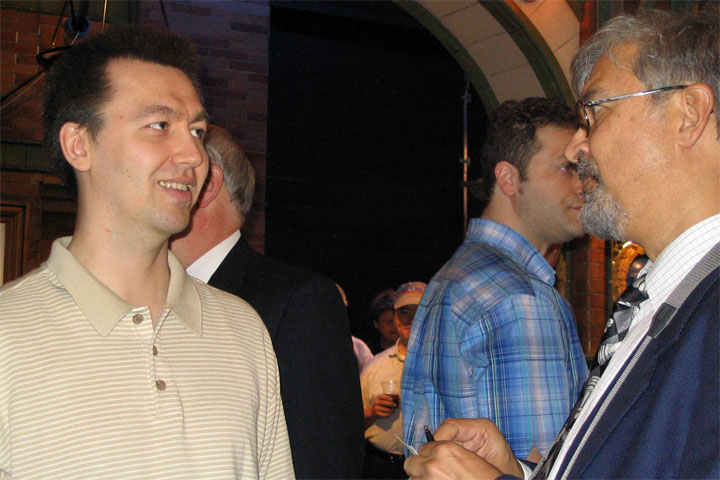
But Gata simply walked over to me, smiled and said, "Hey, Frederic, let's bury the past and be like normal people." And that is the way it has been ever since. Thanks Gata!
All Fritz history articles































